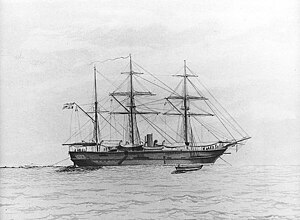 Drawing of SMS Adler by Rear Admiral L.A. Kimberly, U.S. Navy
| |
| History | |
|---|---|
| Name | SMS Adler |
| Namesake | German word for "eagle" |
| Builder | Kaiserliche Werft Kiel |
| Laid down | 1882 |
| Launched | 3 November 1883 |
| Commissioned | 27 May 1885 |
| Fate | Wrecked, 16 March 1889 |
| General characteristics | |
| Class and type | Habicht-class gunboat |
| Displacement | Full load: 1,040 t (1,020 long tons) |
| Length | 61.8 m (202 ft 9 in) |
| Beam | 8.8 m (28 ft 10 in) |
| Draft | 3.11 m (10 ft 2 in) |
| Installed power |
|
| Propulsion | |
| Speed | 11 knots (20 km/h; 13 mph) |
| Range | 2,000 nmi (3,700 km; 2,300 mi) at 9 kn (17 km/h; 10 mph) |
| Complement |
|
| Armament |
|
SMS Adler was the third and final gunboat of the Habicht class built for the German Kaiserliche Marine (Imperial Navy) in the early 1880s. Intended to serve abroad, the ship was ordered as part of a construction program intended to modernize Germany's fleet of cruising vessels in the mid-1870s. The Habicht class was armed with a battery of five guns, and was the first class of German gunboat to use compound steam engines. The ship had a top speed of 11 knots (20 km/h; 13 mph).
Adler was completed in 1884, but spent the next two years in reserve. She was activated in 1886 for a deployment to the South Pacific. She initially cruised in German New Guinea, before moving to Samoa in 1887. Over the next two years, she patrolled the islands to defend Germans in the area, and in late 1887, she carried the deposed king Malietoa Laupepa into exile. The next year, members of her crew and those of German vessels Eber and Olga fought in the First Battle of Vailele, where they were ambushed by a significantly larger Samoan force and suffered heavy casualties.
On 16 March 1889, Adler, Eber, and Olga were anchored in Apia, Samoa, along with three American warships and several other merchant vessels when a major hurricane struck the islands. All of the ships in the harbor were wrecked, including Adler, which was driven into a reef and destroyed. Twenty men from her crew were killed, though Samoans rescued the remainder. Her wreck was never removed, and was used as a recreational swimming site by the Samoans.